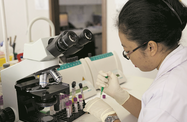Mongolia: Investing in health
As Mongolia sits on the verge of a resource-related boom, government officials are stressing that the Human Development Fund (HDF) established to channel revenues from mining projects to health and education is fulfilling its role.
D. Zorigt, the minister of mineral resources and energy as well as the head of the Mongolian People Party's working group on the HDF, told local media in January that the fund is being used to build wealth for future generations and to bring vulnerable social groups such as students and herders under the government's umbrella of health insurance.
“Mining and infrastructure are important,” said Zorigt. “But more important is the development of health, education, social insurance and a place to live. The money in the fund will be invested in these.”
The Mongolian parliament endorsed the National Development Strategy in 2008 with the goal of raising Mongolia’s human development status to that of developed countries by 2020. The HDF was also created in 2008 following the study of resource wealth management strategies in Chile, Alaska and Norway in hopes of building a system to ensure each Mongolian takes a share of the nation’s mineral wealth.
Initial capital for the fund was drawn from the vast Oyu Tolgoi copper and gold mine project. That mine is estimated to account for 30% of Mongolia’s GDP when completed in 2013, generating $30bn in tax revenue over 50 years, according to the Brookings Institution, a public policy organisation in Washington, DC. Additional revenues for the HDF will come from development of Mongolia’s $2bn Tavan Tolgoi coking coal deposit, the largest in the world.
In November, S. Bayartsogt, then the minister of finance, announced that by July 2012 the HDF will allocate MNT128,000 ($90) to every citizen. Additionally, women aged 55 and over, men aged 60 and over, as well as the disabled, are to receive a one-time allowance of MNT1m ($704), said Bayartsogt.
Human development indicators compiled by the UN Development Programme (UNDP) revealed last November that the HDF is already having an impact, with Mongolia ranked 110th out of 187 countries. It garnered a Human Development Index of 0.653, up from 0.647 in 2010, which is measured by life expectancy, access to education and standard of living, and linked to gross national income per capita (graded from 0.1). The UNDP found between 1980 and 2011, Mongolia’s life expectancy at birth had increased by 11.2 years, mean years of schooling had risen by 2.6 years and expected years of schooling had increased by 3.3 years.
Officials stress education is another key area of the HDF's focus, with 133,000 students set to receive MNT500,000 ($352) from the fund for tuition fees in 2011, Yo. Otgonbayar, the minister of education, culture and science, told local media in August 2011. The government has committed to continuing these payments in 2012, with each student to be granted MNT491,960 ($346). The fund also pays for a student’s health insurance.
A further MNT9.3bn ($6.5bn) had been spent from the HDF on attracting new members to the country's health insurance scheme, Prime Minister S. Batbold said. As the world’s least densely populated country, Mongolia faces unique challenges in health care provision, including severe under-investment in the 1990s, the country’s vast expanses and herders’ nomadic lifestyle.
According to the Ministry of Health, as of 2009, there were 2.57 physicians per 1000 population in urban areas, with 2.75 physicians per 1000 in rural areas. The country was home to 16 specialised hospitals, four regional diagnostic and treatment centres, 17 subdivision (aimag) general hospitals, 12 district general hospitals and six rural general hospitals.
J. Tsolmon, Mongolia’s vice-minister of health, told media in November 2010 the country's health system was “in a transitional phase from a Soviet to a modern era. Lack of infrastructure and bad roads make proper treatment and diagnosis difficult. This is why people often get diagnosed late,” she said.
While Mongolia's HDF has the potential to vastly contribute to the nation's well-being through improving health services, exactly where funds are to be allocated will continue to be a divisive political issue, with implications on parliamentary elections in June of this year, as well as presidential elections scheduled for May 2013. Improving the long-term capacity of the country’s health sector, however, could prove a prudent way to invest the mining sector’s forthcoming wealth back into the country.


